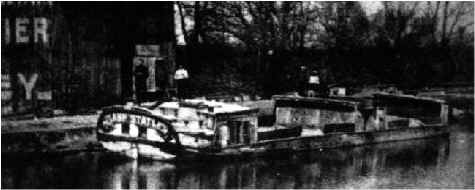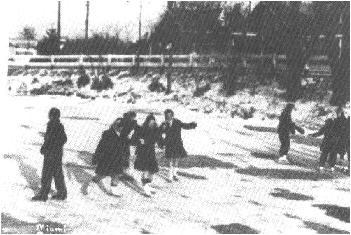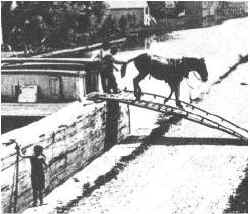Canal Operations

|
The entire canal system,
including the Miami and Erie Canal, was operated by workers employed by the state.
Five superintending engineers and a number of division superintendents oversaw the
operations. Each division had its own complement of toll collectors, locktenders,
and common laborers. Laborers maintained the canal bank and locks. Compared to
travel by horse over rutted and muddy trails, travel on the canal was relatively
enjoyable. The average boat traveled about three to four miles an hour. A team
of three mules traveling the tow path pulled the craft along a 90-foot rope. Another team
was quartered on board, and the animals were changed about every six hours or when the
boat stopped for a lock.
Boat owners competed for the passenger and freight business.
Each boat was given its own name. When the name was registered with the state, no other
boat could use it. Local boats bore names such as 'DeCamp Statler' (shown above),
'Clarion', and 'Lenita.' Passenger boats were usually
painted with lively colors. More than 400 boats were traveling up and down the Miami &
Erie Canal by 1850.
Each boat typically carried a captain and his family, two drivers for the mules, a
steersmen, and a bowsman. The owner of the boat automatically assumed the rank of
'captain.' He would usually wear a distinctive hat, such as a stovepipe, or a uniform of
some sort. The captain and his family lived in a cabin in the rear of the boat. Canal
families spent years on the canal, with children attending school only when the boat tied
up in the winter when travel was impossible. The life of the canalers in the summer
was a monotonous grind of passing through mile after mile of algae-covered canal waters,
spiced from time to time by stops in villages such as Lockington. |

|
Winter months brought ice skating on
the smooth surface of the canal. Charles Ludwig, in his book "Playmates of the
Towpath: Memories of the Canal Swimmers Society", recalled that: "Skating at
times was too tame, and to liven things up we would cut holes in the ice, blocks of about
four feet square and five inches thick, usually four or five blocks. Running across these
was called 'playing ticklish.'...I did it once too often, and felt the icy chill of the
canal at ten above zero." |
The following
interesting advertisement appeared in the May 7, 1852, edition of the "Shelby
County Democrat": "Captain Kingseed has taken charge of the packet boat Clarion and will run regularly between Sidney and Lockport (now known as Lockington) connecting
with lines running north and south. The Clarion will depart from Sidney daily at 1
o'clock P. M. and return the same evening at 9 until further notice." The
advertisement noted that tickets were 50 cents to Piqua, Troy, $1, Tippecanoe (now Tipp
City), $1.50, and Dayton, $2.25.
Working on a canal boat must have been an interesting
experience. An article by Margie Wuebker appearing in "The Sidney Daily News" on March 31,
1990, recounted the experiences of New Bremen native Louis Doenges (shown at right). He
worked on a canal boat from 1856 to 1862. Doenges was just 7 years old when he completed a
14 week trip across the Atlantic to New York with his family in 1847. They joined
relatives outside New Bremen after traveling to Toledo and then down the canal.
Nine years later, he slipped aboard a canal boat in New Bremen. The 16 year old begged
the boat captain for a job. "What can you do," the captain asked. "Well,
mister, I can certainly ride a mule!" Doenges replied. For the next 2 years, he
rode the boat, taking his turn prodding stubborn mules along the tow path for $20 a month.
Work shifts were five to six hours, with the boys changing when the mules were changed.
(Cruelty to the mules used on the canal was apparently an issue. The author of an article
in "The Sidney Daily News" on August 3, 1885, pointed out: "The
drivers in many cases appear to make less sense than the mules, and make a most brutal use
of the whip...A handsome fine would have a tendency to limit the abuse, without
obstructing canal traffic.")
were changed.
(Cruelty to the mules used on the canal was apparently an issue. The author of an article
in "The Sidney Daily News" on August 3, 1885, pointed out: "The
drivers in many cases appear to make less sense than the mules, and make a most brutal use
of the whip...A handsome fine would have a tendency to limit the abuse, without
obstructing canal traffic.")
Doenges recalled the many arguments that took
place when captains of the boats disagreed over who had the right of way. Ladies on board
carried a heavy shawl that they would put over their ears when the swearing commenced.
Each boat carried a muscular fighter to represent the captain in settling the matter if
the dispute resulted in a fight.
Drinking and violence were common on the canal. When the boat carried a cargo of rum, one barrel
was always opened for the crew. Drinking sometimes led to fights. Doenges remembered his
captain being stabbed to death during one altercation on the boat. The 16 year old must
have grown up in a hurry. Louis Doenges' great-grandson, also named Louis, recalled his
namesake in the 1990 interview: "He was a tough old buzzard. He didn't say much,
but we learned to keep an eye on that cane. When he rattled it against the chair, we knew
it was time to settle down and mind our elders."
Living alongside the canal also proved to be an interesting experience for some. In an
interview given in 1991, Mrs. Joseph Avy of Lockington recalled that nearby gardens were
raided by those walking with the canal boats. "Many of the crews would ravish
nearby hen roosts and gardens, and 'mosey along."
'Canal' segment written in
December, 1998 by Rich Wallace
[ Back to Canal Index ]

